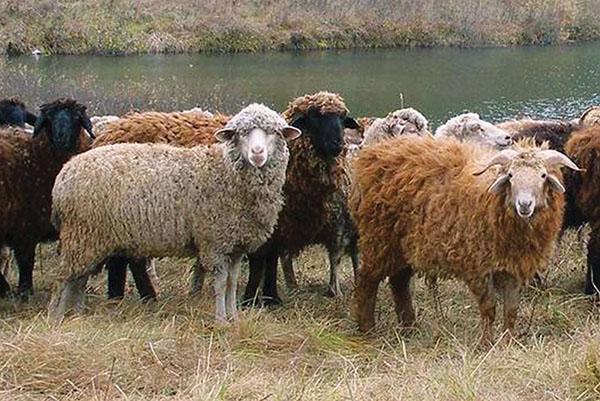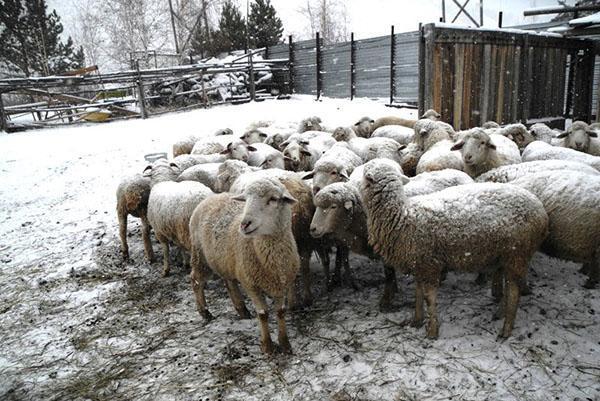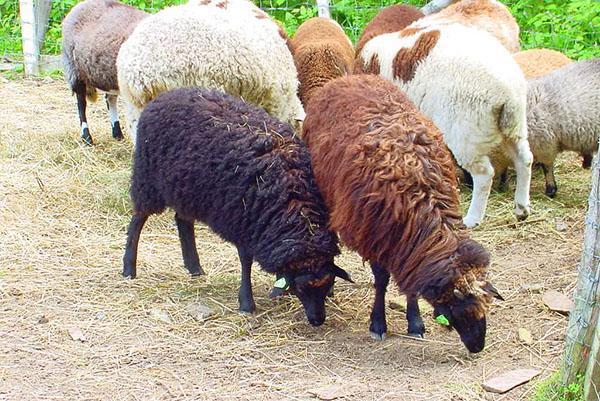Keeping and breeding sheep at home
 Sheep have been raised as domestic farm animals for thousands of years. At the same time, depending on the breed, sheep breeding is carried out in order to obtain meat, milk, sheepskin and warm high-quality wool.
Sheep have been raised as domestic farm animals for thousands of years. At the same time, depending on the breed, sheep breeding is carried out in order to obtain meat, milk, sheepskin and warm high-quality wool.
In the conditions of a personal backyard, keeping sheep will not be difficult. Hardy, unpretentious animals rarely get sick, are fertile enough and, in comparison with cattle, are extremely early maturing. At the same time, no capital built premises are required for sheep:
- In summer they are content with paddocks and grazing areas.
- In winter they are kept in sheepfolds, where the temperature is slightly above zero.
Animals grow well on feed, which is clearly not enough for other species to meet physiological needs. Sheep, on the other hand, have enough vegetation to grow, give wool, and gain weight.
With due attention to animals, raising sheep at home and for novice sheep breeders will not seem like a difficult burdensome task. Good care, observance of the rules of keeping and feeding will necessarily result in high meat productivity in the first year, obtaining tasty fatty milk and homemade wool.
Biological characteristics of sheep
 Modern breeds of sheep for raising at home can show high productivity in terms of meat, milk and wool. Most often, the attention of sheep breeders is attracted by varieties with high fertility, rapid weight gain, pronounced unpretentiousness and good health. But in order for animals to show the expected results, it is necessary to take into account their needs and the biological characteristics of the sheep.
Modern breeds of sheep for raising at home can show high productivity in terms of meat, milk and wool. Most often, the attention of sheep breeders is attracted by varieties with high fertility, rapid weight gain, pronounced unpretentiousness and good health. But in order for animals to show the expected results, it is necessary to take into account their needs and the biological characteristics of the sheep.
Among the animals in the barnyard, sheep are famous for their herd and forgetfulness. Often sheep breeders are faced with the fact that the livestock left for grazing cannot find their home. Therefore, sheep and rams are taken out to the walking grounds together with the smart ones. goats or cows. In this case, it is worth one sheep to go after the "leader", and the whole flock will reach for it.
 The average life of a sheep is 20 years. However, when keeping sheep in a private backyard, only producers and thoroughbred queens can live up to 8 years. Young animals raised for meat are slaughtered until the age of one year, and individuals of a wool nature are kept on the farm a little longer.
The average life of a sheep is 20 years. However, when keeping sheep in a private backyard, only producers and thoroughbred queens can live up to 8 years. Young animals raised for meat are slaughtered until the age of one year, and individuals of a wool nature are kept on the farm a little longer.
One of the indicators by which the merits of a breed or an individual are judged is the number of lambing per year and the number of lambs brought.
Most often, sheep in breeding produce offspring once a year at the end of winter or in the first days of spring. Gestation lasts about five months, with most breeds having one lamb is the norm. But there are also exceptions.
For instance, Romanov breed of sheep, popular among Russian sheep breeders due to the frequent birth of several lambs at once and the ability to kitten twice a year. This feature of the breed and the early maturity of the species as a whole allows you to develop a completely successful, quickly payback business plan for breeding sheep.
What conditions do animals need? How to arrange their feeding? How to start raising sheep at home for beginners?
Raising sheep at home in summer
 Sheep grazing is the basis of their high productivity. By depriving animals of the opportunity to go out for a walk, a sheep breeder can seriously reduce his profit.In this case, costs increase:
Sheep grazing is the basis of their high productivity. By depriving animals of the opportunity to go out for a walk, a sheep breeder can seriously reduce his profit.In this case, costs increase:
- for feed, the collection and preparation of which is now a human concern;
- for the equipment of premises and shelters for sheep.
If there are no suitable pastures near the courtyard, the sheep are arranged with walking areas, fencing the plots with shields. After the depletion of the grass cover, the flock is transferred to the neighboring territory. Since sheep can bite off the grass lower than goats or cows, even in the poorest places, they find enough favorite food for themselves. In addition, the transfer of grazing to another part of the pasture helps to prevent infection of animals with helminths.
At home, when raising sheep without walking, the animals are given cut pasture grasses.
It is also advisable to arrange small runs for the flock, driving them out of the confined space for a walk. It is possible to keep the sheep on a leash with regular transfer to a new site.
 Sheep are released to the pasture with the arrival of spring and the appearance of the first vegetation with a height of about 8 cm. If it is cool outside, animals should be protected from excessive moisture, be it rain or dew. Wet wool does not dry out and causes various diseases of animals. The same rule is followed with the onset of autumn coolness. In hot summertime, on the other hand, going out early to the meadow will help the sheep find the juiciest vegetation.
Sheep are released to the pasture with the arrival of spring and the appearance of the first vegetation with a height of about 8 cm. If it is cool outside, animals should be protected from excessive moisture, be it rain or dew. Wet wool does not dry out and causes various diseases of animals. The same rule is followed with the onset of autumn coolness. In hot summertime, on the other hand, going out early to the meadow will help the sheep find the juiciest vegetation.
Despite the grazing, the sheep are always offered water. Drinking bowls are replenished twice daily, and in especially hot seasons - three times a day.
This measure will help protect animals from dehydration and weakening. For the same purpose, sheds are equipped, where the flock can wait out the most sultry hours. Here, not only drinkers and feeders are placed for the sheep, but also pieces of lick salt.
 Pasture grass is the most desirable and useful food for sheep. However, sheep breeding provides for their maintenance in the cold season. Therefore, the sheep breeder needs to prepare hay on time, and in the autumn, fallen leaves will become a good help with a shortage of grass.
Pasture grass is the most desirable and useful food for sheep. However, sheep breeding provides for their maintenance in the cold season. Therefore, the sheep breeder needs to prepare hay on time, and in the autumn, fallen leaves will become a good help with a shortage of grass.
In summer, sheep can suffer from blood-sucking insects, which not only use the sheep as a food source, but also lay eggs on damaged skin. In order to avoid diseases associated with this and to make life easier for the wards, the animals are examined, cleaned and disinfected, and the weakened sheep are under special supervision.
Keeping sheep in the cold season
 The arrival of autumn for the sheep breeder means that the flock will soon be relocated to the winter sheepfolds and sheepfolds. It is extremely important to protect wards from drafts, excessive moisture and crowded content. Therefore:
The arrival of autumn for the sheep breeder means that the flock will soon be relocated to the winter sheepfolds and sheepfolds. It is extremely important to protect wards from drafts, excessive moisture and crowded content. Therefore:
- The premises are equipped with ventilation.
- Arrange dry deep bedding for the animals.
- One individual is allocated from 2.5 to 3 meters of area.
- The inside of the sheepfold is kept at a temperature of 6–8 ° C during the stall period. This is enough for healthy strong animals to feel good, and with a well-chosen diet and grow.
- During the most crucial period in sheep breeding - during lambing, the air in the sheepfold should be warmed up to 15 ° C.
In winter, the sheep ration consists of silage hay harvested in the summer, chopped root crops and a small amount of concentrated feed. For 500 kg of grass hay and the same amount of root crops, only 100 kg of compound feed should fall. This rate is sufficient to feed one adult during the stall period.
 During the cold season, feeding is best done outdoors in an open sheep pen. In bad weather, feed is given under a canopy. Do this 3-4 times a day. The sheep get hay first. For weight gain and growth, it is beneficial to give hay from grains and forage legumes.
During the cold season, feeding is best done outdoors in an open sheep pen. In bad weather, feed is given under a canopy. Do this 3-4 times a day. The sheep get hay first. For weight gain and growth, it is beneficial to give hay from grains and forage legumes.
Then the sheep are offered succulent food. This can be a mixture of chopped root vegetables, for example beets, carrots, turnips, bran potatoes. Another option is silo.After such a meal, the herd is given a drink, and then it is the turn of concentrated and roughage. Sheep, when raised at home, quickly get used to one feed distribution schedule. In the evening, hay and brooms prepared in the summer are laid in the feeders.
Thanks for the interesting article. I myself plan to start raising sheep in the country.